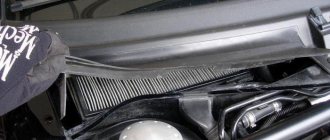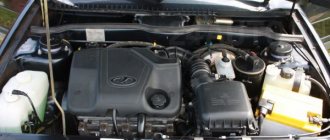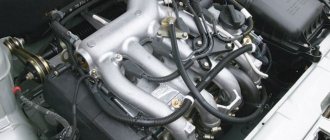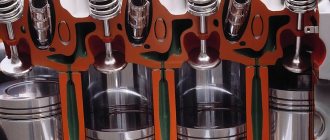Have you encountered engine problems when the car stalls in traffic jams or the engine speed is unstable? There may be several reasons for these malfunctions. It is recommended to start searching for a problem with diagnostics, and if this is not possible, then first perform a check, and only then change the faulty parts.
AvtoVAZ installs the same type of engines on modern Lada cars (Kalina, Granta, Priora, Largus, Vesta, Niva or XRAY), so the solution to problems for all these cars is similar.
The idle speed fluctuates, the engine stalls when moving (on the move) or at a standstill, the reasons may be the following:
- The engine air filter is clogged.
- The spark plugs are faulty.
- High voltage wires are faulty.
- Ignition module/coils are faulty.
- The idle air control (IAC) or its electrical circuits are faulty.
- The throttle position sensor (TPS) is faulty or the throttle assembly is dirty.
- The mass air flow sensor (MAF) is not working.
- The oxygen sensor (OS) or circuits are faulty.
- There is insufficient pressure in the fuel rail.
- Compression in the cylinders is low.
- The exhaust system is leaking.
- Air leaks through the crankcase ventilation hoses and the hose connecting the intake pipe to the vacuum brake booster.
- The cylinder head gasket is damaged.
- The timing belt or tension roller is worn.
- The camshaft cams are worn.
- The valve timing is off. Check the alignment of the marks on the crankshaft and camshaft.
- The engine control unit (ECU) or its circuits are faulty.
Have you encountered floating engine speeds? What was the cause of the malfunction? We solve such engine problems in the comments or on the forum. Let us remind you that along with unstable speed there may be other problems, for example, the engine is difficult to start.
The Lada Kalina idle speed sensor or IAC is a device that is responsible for the necessary air supply to the internal combustion engine when it is idling (in the absence of pressure on the gas pedal). For example, the driver releases the accelerator pedal and the air supply to the internal combustion engine stops. To prevent the engine from stalling, the idle speed sensor comes into operation, which is involved in the process of supplying the required amount of air bypassing the throttle assembly.
In other words, the IAC is a kind of valve-regulator. It is very important for every car owner to know and understand the principles of operation of the product, because if it breaks down, in most cases the car’s self-diagnosis system does not determine the reason for the incorrect operation of the engine.
Idle speed regulator Lada Kalina and its device
- a housing in which a stepper motor is located with two windings independent of each other, rotor supports (rear and front);
- valve shut-off needle and spring;
- power connector.
3 main functions of the controller
1. In addition to maintaining the required engine speed, the device ensures its proper operation under cold start conditions (warming up at sub-zero air temperatures). In this case, the regulator provides higher engine speeds until the latter warms up to operating temperature. 2. The second important function that many drivers don’t even think about is the speed maintenance mode without pressing the gas pedal. In other words, ensuring the engine operates at idle speed is the merit of the IAC. 3. The third and very important purpose of the product is to ensure the creation of an air-fuel mixture of the required concentration and saturation. This feature has a positive effect on final fuel consumption and smooth engine operation.
Design features of the Lada 11194 16 valve engine
The 1.4-liter internal combustion engine is based on the 1.6-liter VAZ 21126 by reducing the piston diameter. The combustion chamber, which was reduced as a result, deprived the unit of normal traction at the bottom, and therefore it is not very comfortable to constantly move in dense city traffic.
As in the donor, a lightweight connecting rod and piston group from Federal Mogul is used here, which, with all its advantages, has one disadvantage: if the timing belt breaks, the valve bends 100%. And the presence of hydraulic compensators allows you not to have to adjust valve clearances. In all other respects, this is a typical VAZ sixteen-valve engine, only of a smaller volume.
At one time I wrote about this engine at the wheel, although comparing it with the ICE 21124
Source
Cross section of engine 11194*: 1 — oil pan drain plug; 2 - crankshaft; 3 - oil filter; 4 - catalytic manifold; 5 — coolant pump; 6 - piston; 7 — catalytic manifold gasket; 8 — oxygen concentration sensor; 9 — spark plug; 10 — exhaust valve; 11 — cylinder head; 12 — exhaust camshaft; 13 — camshaft bearing housing; 14 — cylinder head cover; 15 — intake module; 16 — inlet valve; 17 — ignition coil; 18 — hydraulic pusher; 19 — intake camshaft; 20 — nozzle; 22 — diagnostic fitting of the fuel rail; 21 — fuel rail; 23 — cylinder head gasket; 24 — piston rings; 25 piston pin; 26 — cylinder block; 27 fitting of the crankcase ventilation system; 28 — connecting rod; 29 — connecting rod bearings; 30 - flywheel; 31 — oil pan gasket; 32 — oil intake; 33 — engine sump
The car is equipped with a model 11194 engine. The engine is a gasoline, four-stroke, four-cylinder in-line engine with overhead camshafts and liquid cooling.
The cylinder block is cast iron, with cylinders machined into it. The internal cavities of the block for coolant are formed during casting, and the oil supply channels are made by drilling. There are five crankshaft main bearing supports located at the bottom of the cylinder block. The main bearing caps are not interchangeable and are marked with the bearing serial number, starting from the crankshaft pulley. The cover of the second main bearing has two threaded holes for the oil intake bolts. Steel-aluminum main bearing liners are installed in the supports and covers. On both sides of the third main bearing support there are sockets for installing thrust half-rings that prevent axial movement of the crankshaft. The front half-ring is steel-aluminium, the rear half-ring is metal-ceramic, yellow on both sides.
The engine differs from previous models of commercially produced VAZ engines in its lightweight connecting rod and piston group.
Short skirt pistons are cast from aluminum alloy. There are four small recesses in the bottom of each piston for the valve plates, but they do not prevent the valve from contacting the piston in the event of a timing violation or a broken timing belt. Each piston has two compression rings and one oil scraper ring. The lower compression ring is of a scraper type with a groove and a sharp edge on the lower plane. A spring expander is installed inside the oil scraper ring. All rings are thinner than on previous engine models, which is designed to reduce internal engine friction losses.
The pins are of a floating type, fixed in the pistons by two spring retaining rings.
The connecting rods are “chopped”. A steel-bronze bushing is pressed into the upper head of the connecting rod. The connecting rod caps are not interchangeable and are installed on the connecting rod in only one position. The oil pan is attached to the bottom of the cylinder block. The engine lubrication system is combined under pressure and splashing. The oil pump is a gear type with internal gearing and driven from the front end of the crankshaft. Through the oil intake, the pump takes oil from the oil pan and pumps it under pressure into the channels of the engine lubrication system. To control the amount of oil in the pan, a dipstick is installed - a level indicator. The oil filter is full-flow, with a paper filter element and a check valve that prevents oil from flowing out of the lubrication system channels into the oil pan after stopping the engine.
Oil nozzles are installed in the main bearing supports. Oil from the injectors is supplied to the internal surfaces of the pistons to cool them. Some of the oil falls on the upper heads of the connecting rods and flows through the conical holes made in them onto the piston pins, lubricating them.
Channels are drilled into the crankshaft body. Through them, oil flows to the connecting rod journals, lubricating them. Oil enters the crankshaft channels from the cylinder block through holes in the main bearing shells and main journals. The technological openings of the channels are closed with stamped steel plugs.
On the left side of the block there is a cavity for installing a coolant pump and a boss for installing an oil filter.
An aluminum head is installed on top of the cylinder block. The connection between the head and the cylinder block is sealed with a metal two-layer gasket. The cylinder head contains two camshafts and sixteen valves. The valves are driven through pushers with hydraulic compensators. Therefore, adjustment of thermal clearances in the valve drive is not required. The intake and exhaust camshafts are not interchangeable. The camshaft supports are made in the head, and their covers are combined into a bearing housing mounted on the head. The bearing housing is closed on top by a cylinder head cover with an oil deflector and an oil filler neck. To install spark plugs, cylindrical recesses are made on top of the cylinder head - spark plug wells. An ignition coil is inserted into each well. In this case, the high-voltage terminal of the coil is placed on the spark plug.
The camshafts and coolant pump are driven by a toothed belt from the engine crankshaft. To guide the movement of the belt along the pulleys, a guide roller is installed; the belt is tensioned by a tension roller with an automatic tensioner. The timing belt is covered with plastic covers.
The generator is driven by a serpentine belt from the engine crankshaft pulley.
The receiver and inlet pipeline are one-piece, made of plastic as a single unit. The exhaust manifold is steel, combined with a catalytic converter. Its connection to the head is sealed with a two-layer metal gasket.
Basic data for monitoring, adjustment and maintenance
Source
Where is the idle speed sensor on Kalina
Due to its purpose, the product is located directly in the throttle assembly next to the throttle position sensor.
Signs indicating malfunctions
Some signs indicating improper operation of the unit: - problems with starting the engine (it is possible to start only by repeatedly pressing the gas pedal); — floating speed when switching gears to neutral; — when changing gears, the car stalls completely or choke; — it is difficult to warm up the engine in the cold season (engine speed does not increase above 1500 rpm); — when additional energy consumers are turned on (stove, air conditioning, heating and others), the idle speed is lower than the operating values, or constantly floats.
If you observe one or more of the above situations, pay attention to the idle speed sensor for the 8 valve Kalina and carry out diagnostic measures.
The main reasons for tripling
If you say that your engine is not working, many will answer that the cylinder is not working. But this argument is not entirely correct, since the cylinder stops working properly. However, there may be several reasons for this:
- Compression in cylinders is too low;
- The spark plug is faulty or partially does not perform its functions;
- The valves do not fit well due to a long lack of adjustment;
- The injectors are dirty or overfilled and therefore need to be replaced;
- The oxygen sensor has stopped functioning;
- The high-voltage spark plug wire has been damaged;
- The ignition coil is faulty;
- DPKV (crankshaft position sensor) does not work;
- The ECU (electronic control unit) is broken;
- The timing belt has fallen off or simply slipped a few links;
- The air filter is faulty or dirty.
Some problems literally appear immediately in the form of a failed cylinder, but others may only appear after some time. And this is the most undesirable scenario for the development of events.
Primary signs of a problem that may indicate a cylinder failure are:
- Vibration increases because the rhythm of the valves and other rotating parts of the gearbox and power unit is disrupted.
- Fuel consumption increases noticeably because the injection system no longer works properly.
- An unpleasant characteristic odor is heard from the exhaust pipe, which is explained by the high level of concentration of harmful impurities and unburned fuel.
- The power of the power unit drops noticeably, which negatively affects the dynamics and maneuverability of the car.
If you notice that the engine is shaking, but have not taken any measures, this will soon threaten you with complete failure of the engine, which may be impossible to repair.
When the injection 8-valve engine on a VAZ 2114 is running, fuel constantly flows into the non-working cylinder. It does not burn, but mixes with oil and then goes into the crankcase.
If the process continues for a long time, the oil loses its viscosity, ceases to act as a lubricant, parts work under extreme loads, and the metal turns into chips. There is nothing good about this, let's be honest.
Examination
3 popular ways to diagnose the causes of a malfunction
Among professionals and car enthusiasts, there are many ways to check the performance of the sensor. But we will dwell in detail only on the most effective and simple methods:
- First method. The point of this method is to check the operation of the sensor itself. To do this, you need to remove the product from its mounting location, take it in your hand, connect the power contact block to it (if it is not connected) and start the car engine. In this case, on a working device, when the engine starts, the sensor needle should extend. If this does not happen, then its operation is impaired or the device is faulty.
- Second method. Assumes the use of a voltmeter. The task is to check that the correct voltage is supplied to the sensor. To do this, the sensor is disconnected from the contact chip, and a measuring device is connected to its terminals. After which, the ignition is turned on, and all the terminals of the contact chip are analyzed one by one. The operating resistance parameters should be about fifty ohms or tend to infinity. The voltage level should be 12 volts. If the voltage reading is less, this indicates improper operation of the battery or the cause is related to an open circuit or operation of the computer.
- The third approach involves checking the resistance of the external and internal windings of the sensor. Measuring work should be done using a multimeter. The contact parameters after measurements should be in the range from 40 to 80 Ohms. If there is a deviation or zero values of the device during measurements, the IAC must be replaced.
Troit in wet weather
The question very often arises: “Why does the engine stall in wet weather, that is, in high humidity?” Quite often, drivers have problems starting the engine in wet weather, and after an overnight stay, the car does not want to obey at all.
Especially in the morning, when everyone is rushing to work, a problem arises with the fact that the car either stalls or does not even show symptoms of operation, and everything lies in only one thing - excessive humidity. But how can you determine where moisture is very high and how it got there?
How to figure out what is causing problems in wet weather?
If you have carried out a visual inspection of the car under the hood and did not see any wet places, as well as any indicators of damage, the first thing you should do is start the engine.
We achieve success only on the 5th, or even 10th attempt, the grip occurs only 4-5 times, in most cases, even 10 attempts are not enough to successfully start.
If you still start on the first try and do not observe any obvious problems, then you should let the car cool down, after which the problem will repeat. Only after a run of 10 km will the engine start up without causing any problems.
You can check in other simple ways to find the problem. To do this, you should park the car in an unlit place. After this, at night you should open the hood, after which your partner should turn the key to the start.
Condensation formed in the distributor cap.
After checking the injectors and fuel pump, it is best to change the filters; if no problems are found, then there are unlikely to be other problems. It’s not worth going too deep; in this case, you can only blame the condensation that has formed in the distributor cover.
New Lada: Test drives and articles about Lada Kalina
Let's move on to inspecting the cover, studying it from the inside. Of course, you can even dry it, but the distributors are installed differently on different engines, but the vulnerability in them is the same. Therefore, it is worth washing the lid from the inside first with gasoline or degreaser. Then remove the moisture with alcohol.
Why does the engine still stall?
If the “northern lights” are detected, and this happens extremely rarely, it is best to overhaul the engine.
Many of its parts are subject to reassembly: the distributor cover and high-voltage wires, after which, armed with a can of cleaner, the cheapest copy will do to treat everything from accumulated dust and dirt.
Next we treat everything with VDeshka, you can also use silicone spray. Now this problem will no longer bother you during wet weather, and engine stalling will also stop. Now any weather conditions will not affect engine operation. This scenario is the most popular, but you can also encounter other problems.
If you have problems starting the engine, you need to monitor the power of the spark. To do this, we observe the spark located on the central wire from the high-voltage coil. Next, we move on to the cylinders, after which we observe its power in the distributor, whether it remains there or disappears. After all, the reason may be a simple lack of spark that ignites the mixture.
What can you say if the engine in a Logan is misfiring?
After writing the article, I decided to also make a video review, where I told the whole story in detail. If my experience was useful to someone, I was happy to help.
Why troitdvigatel
Lada Kalina
The Kalina engine is malfunctioning - most of the drivers of this Russian car have encountered this problem. With all this, it should be noted that a similar problem is not a proprietary problem of this model, because it is quite common in both other Russian cars and foreign cars.
Replacing the idle speed sensor on Kalina
The operation of installing or removing the product is not particularly difficult and is accessible to any car owner, regardless of the level of training, under almost any conditions. Replacement is carried out in the following sequence: 1. First step. During any work related to the vehicle's electrical system, the on-board system is de-energized (to do this, simply disconnect the battery terminal). 2. Second step. We find the regulator and disconnect the contact block with the supply wires from its body. 3. Third step. Using a long Phillips screwdriver, unscrew the mounting screws (2 pieces) and remove the product from the car’s throttle body. 4. We install the new product, the procedure is similar to the removal process only in reverse order. The new sensor does not require adjustment or configuration.
Engine VAZ 11194
The 1.4-liter 16-valve VAZ 11194 engine was produced by the concern from 2007 to 2013 and was essentially a smaller copy of the popular VAZ 21126 power unit. The engine was specially created and was installed only on the Lada Kalina hatchback, sedan and station wagon.
The VAZ 16V line also includes: 21124, 21126, 21127, 21129, 21128 and 21179.
conclusions
The reasons for the unstable operation of the Lada Kalina engine at idle have been established and can be eliminated with your own hands. But, for those who do not know the structure of the car or cannot troubleshoot, you should contact a car service center.
Yes, with the number of possible reasons for tripling, it doesn’t seem like enough. But if we look for that one reason each time step by step, that is, blindly, it will take so much time that it won’t seem like enough. In practice, you often guess it by some instinct.
I had a problem with the spark plugs. Diagnosed and replaced at a car service. Then everything returned to normal.
Fuel filter. Replaced it and ran and the idle leveled out
What 5 ohms? From 4 rooms to 10 rooms.
And I changed the idle speed sensor, and I changed something else... I just came from the service center to clean the injectors. Tomorrow I’ll see if they helped.
If with E gas then it could be a throttle body, air flow sensor, coolant temperature sensor, air suction, vacuum reservoir or hose from it to the receiver, injectors. the current regulator that is in the generator causes the voltage to jump; the spark is weak! crankshaft sensor, phase sensor if the pedal is cable, lambda, ecu. )))
The speed sensor still has a coating of chips on it...
Source
Advantages and disadvantages
The advantages of ICE 11194 are:
- economical fuel consumption;
- the cylinder head has reduced combustion chamber volumes;
- ducts for cylinder cooling jackets are made between the cylinders.
However, a decrease in diameter is expected to cause the following disadvantages:
- torque has decreased;
- at medium and low speeds there is a loss of power of about 10 hp. With.;
- the user has to spin the motor;
- When the timing belt breaks, the piston bends the valve.
The modification of the 11194 engine did not receive further development; this is where the experiments of the manufacturer AvtoVAZ with volumes less than 1.6 liters ended. Already in the second generation Lada Kalina this internal combustion engine was not included in the configuration.
Engine VAZ 11194 1.4 l
The VAZ 11194 engine appeared 3 years after the first Lada Kalina hatchback rolled off the assembly line. It was an experimental economical version of the drive to comply with the Euro3/4 eco-standard. The engine did not last long, since the torque turned out to be insufficient, and the manufacturer AvtoVAZ, starting with the Kalina-2 version, decided to completely abandon the 1.4 liter internal combustion engine. The lower bar now starts with an engine volume of 1.6 liters.
Debugg
The easiest way to check the assumption that a particular component is faulty is to replace it with a known good one. Spark plugs, armored wires, modules (coils), injectors, sensors - even if they are completely new, it is advisable to check the basic parameters before installation (the case of a manufacturing defect cannot be ruled out) so that such a replacement does not lead the search for a breakdown in the wrong direction.
Each car brand has its own design differences that affect the difficulty of accessing problematic spare parts.
A normal detailed computer scan will allow you not to change everything, but to immediately calculate the causes of the failure.
Taking your car to a trusted service center for diagnostics is a completely rational step. Especially considering the fact that you won’t have to travel separately to get new components - they can be installed right at the inspection site.
Design Features
By reducing the volume of the combustion chambers to 1.4 liters in the 21126 engine, which had 1.6 liters, the 11194 engine received pistons measuring 76.5 mm, a cylinder block height of 197.1 mm with special surface treatment using Federal Mogul technology. A special feature of the internal combustion engine is the bending of the valves when the timing belt breaks, so from the assembly line it is equipped with a belt and roller from the manufacturer Gates, which have a declared service life of 200,000 km.
Modification 11194 became the only power drive for front-wheel drive cars with a cylinder diameter of 76.5 mm, so an individual cylinder block was created for it. AvtoVAZ purchases connecting rod and piston sets from the American company Federal Mogul. By default, the surfaces of the friction pairs are treated with honing, so pistons and connecting rods from domestic manufacturers available in stores without such treatment cannot have the same high service life initially.
A detailed description of the parameters of the 11194 motor contains only the manufacturer’s manual. It also indicates the sequence of repair operations for individual components. Inside the main bearing supports, nozzles are installed that spray oil to cool the pistons, similar to engines 21126 and 11193.
Crankshaft used from 11183:
- crank radius increased to 37.8 mm;
- the landing dimensions are the same as 2112;
- the damper driving the attachments is retained from 2112;
- toothed pulley applies from 21126.
Almost all AvtoVAZ engines are “construction kits” with interchangeable parts, which makes it easier to overhaul, including doing it yourself if you have the necessary qualifications.
What to do if the car jerks after washing
When the engine stalls after washing, you need to have some kind of action plan (make a checklist) to identify the reasons. But before that, you should once again wipe the motor and wiring dry, blow all areas with air from the compressor, and clean all contacts from plaque. For hard-to-reach places, it is optimal to use compressed air rather than rags.
By the way, in some places the moisture can dry out on its own if you put the car in a dry, ventilated room. Of course, you need to check the spark plugs. This is not difficult to do, but only if you have a spark plug wrench at hand. If the spark plugs are unscrewed, it is better to clean the electrodes from carbon deposits. In addition, it is necessary to wipe the spark plug wells themselves.
If the driver is completely sure that the engine is dried after washing and the contacts are cleaned, and the spark plugs are in perfect order, but the car still jerks while driving and under load, it is better to immediately contact a service center, where they will carry out in-depth diagnostics and determine the faulty one. cylinder and help fix the problem.











